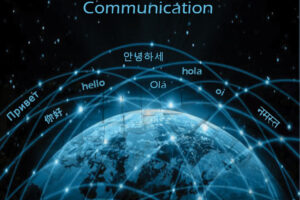By Jackie Damrau, Editor
Books Reviewed in This Issue
The reviews provided here are those that are self-selected by the reviewers from a provided list of available titles over a specific date range. Want to become a book reviewer? Contact Dr. Jackie Damrau at jdamrau3@gmail.com for more information.
Social Media and Society: An Introduction to the Mass Media Landscape
by Regina Luttrell and Adrienne A. Wallace
Where is My Office? Reimagining the Workplace for the 21st Century
by Chris Kane
Transmedia Frictions: The Digital, the Arts, and the Humanities
by Marsha Kinder and Tara McPherson, eds.
About Us: Essays from the Disability Series of The New York Times
by Peter Catapano and Rosemarie Garland-Thomson, eds.
Writing the Novella
by Sharon Oard Warner
You Are Here: A Field Guide for Navigating Polarized Speech, Conspiracy Theories, and Our Polluted Media Landscape
by Whitney Phillips and Ryan M. Milner
The Business of We: The Proven 3-Step Process for Closing the Gap Between Us and Them in Your Workplace
by Laura Kriska
Build Your Cultural Agility: The Nine Competencies of Successful Global Professionals
by Paula Caligiuri
The Corporate Terminologist: Terminology and Lexicography Research and Practice
by Kara Warburton
Global Health: Ethical Challenges, 2nd ed
by Solomon Benatar and Gillian Brock, eds.
Extra Bold: A Feminist, Inclusive, Anti-racist, Nonbinary Field Guide for Graphic Designers
by Ellen Lupton, et al.
Becoming a Writer, Staying a Writer: The Artistry, Joy, and Career of Storytelling.
by Michael Straczynski
Media Technologies for Work and Play in East Asia: Critical Perspectives on Japan and the Two Koreas
by Micky Lee and Peichi Chung, eds.
Advanced Creative Nonfiction: A Writer’s Guide and Anthology
by Sean Prentiss and Jessica Hendry Nelson
The Artful Dickens: The Tricks and Ploys of the Great Novelist
by John Mullan
How to Invent Everything: A Survival Guide for the Stranded Time Traveler
by Ryan North
Creative Writing for Social Research: A Practical Guide
by Richard Phillips and Helen Kara
The Hum of the World: A Philosophy of Listening
by Lawrence Kramer
Career Anxiety: Guidance Through Tough Times
by Saul Carliner, Margaret Driscoll, and Yvonne Thayer
Social Media and Society: An Introduction to the Mass Media Landscape
Regina Luttrell and Adrienne A. Wallace. 2021. Rowman & Littlefield Publishers. [ISBN 978-1-5381-2909-8. 256 pages, including index. US$60.00 (softcover).]
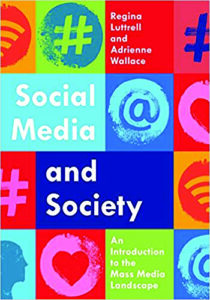 Social media as we know it has been around for almost 20 years. New platforms emerge every year, though, meaning that social media constantly feels novel. Social Media and Society: An Introduction to the Mass Media Landscape does an excellent job placing this relatively new communication mode into established mass media scholarship. However, as this communications textbook points out often, social media stands apart from other mass media because it is participatory. While traditional mass media communication is one-way, social media is a two-way communication.
Social media as we know it has been around for almost 20 years. New platforms emerge every year, though, meaning that social media constantly feels novel. Social Media and Society: An Introduction to the Mass Media Landscape does an excellent job placing this relatively new communication mode into established mass media scholarship. However, as this communications textbook points out often, social media stands apart from other mass media because it is participatory. While traditional mass media communication is one-way, social media is a two-way communication.
One of the most engaging things about this book is its audience awareness. Social Media and Society is targeted to Gen Z students—tech-savvy traditional college students who have spent much of their lives interacting with friends, corporations, celebrities, and organizations on social media. The authors try to connect students’ prior experience with personal social media with its professional use. Using mass media theories, they explain how and why businesses and organizations use social media the way they do. The final chapters discuss social media analytics and briefly introduce professions within the field. These chapters encourage students to combine their personal experience with the professional social media techniques discussed in earlier chapters and present social media communications as a rewarding career field.
Social media platforms rise and fall rapidly (remember Vine and Google Plus?). So instead of diving into how to use certain platforms, the focused discussions in this textbook are on specific communication areas. After establishing what constitutes social media and defining its framework in the initial chapters, authors Regina Luttrell and Adrienne Wallace dig into specific uses of social media, such as entertainment communication (music, television, movies, and celebrities), medicine, business, and crisis communication. Social Media and Society also includes sections on sports communication and civic and political engagement, the two chapters I found the most fascinating. Students who follow college football game scores and participate in their own commentary on Twitter may find the sports communication chapter especially interesting. Civic-minded students will enjoy reading about how online political discussion has evolved and how protest movements move beyond “hashtag activism” and use social media to organize real-world events.
Social Media and Society would be welcome in an introductory communications course. The chapters are engaging and full of relatable, recognizable, real-world examples of social media successes and failures. Each chapter begins with a short scenario that exemplifies the chapter’s focus. The authors also pose interesting questions that will help tie the textbook’s content to the students’ experience with social media. These questions, introduced with clear, consistent signal phrases like “think about it” and “consider the following,” would work as classroom conversation starters or online discussion board prompts.
Elizabeth Hardin
Elizabeth Hardin is an STC member and a lecturer in the English department at the University of Alabama in Huntsville, where she teaches technical and business writing. She has a master’s degree in English and a bachelor’s in Computer Science.
Where Is My Office? Reimagining the Workplace for the 21st Century
Chris Kane. 2020. Bloomsbury Business. [ISBN 978-1- 4729-7868-4. 262 pages, including index. US$35.00 (hardcover).]
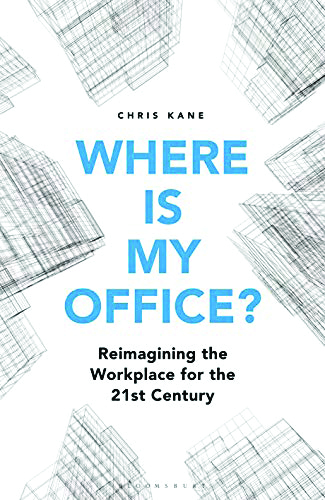 Chris Kane addresses issues such as agile work and hot-desking as he discusses new workplace practices that can help with employee productivity and even lower costs. His perspective comes from his work as the director of Six Ideas, an organization focused on workplace innovation for groups such as Amazon. One section of Where Is My Office? Reimagining the Workplace for the 21st Century is called “The BBC Story: From Analogue to Digital” to reflect part of Kane’s work history.
Chris Kane addresses issues such as agile work and hot-desking as he discusses new workplace practices that can help with employee productivity and even lower costs. His perspective comes from his work as the director of Six Ideas, an organization focused on workplace innovation for groups such as Amazon. One section of Where Is My Office? Reimagining the Workplace for the 21st Century is called “The BBC Story: From Analogue to Digital” to reflect part of Kane’s work history.
One idea in Where Is My Office? is that the focus should be on people and what they do instead of a focus on physical space for getting work done. Another idea concerns a post-pandemic world. This is a world where remote work and flexible work hours may become a new norm. Kane asks why workplaces have not evolved as work has.
Kane’s work with the BBC helped him develop the “Smart Value Formula,” which is a concept that combines spaces for work, shopping, and living (p. 140). The formula also came from the “Everything connects to everything else” idea of Leonardo da Vinci (p. 142). The formula is also meant to contribute to an organization’s success as Kane argues it has for the BBC with its creation of effective content.
Maybe you have worked in a cubicle, a pod, or at home—so you have some idea of ways to organize workspaces. Maybe you have worked in a way that you can still meet responsibilities as taking care of children, elderly family members, and those with special needs. What Kane has in mind in organizing workspaces might be far beyond what we might imagine. But he does factor in many elements when he writes about how to approach designing effective workspaces.
If you are wondering about what Kane thinks about hot-desking (where multiple workers use the same workspace instead of having a personal desk—as used in a city where real estate prices are high), he mentions it is “loved or loathed in equal measure” (p. 104).
As for Kane’s chapter “Delivering Agile Workplaces Across the Nation,” the focus here is on the changes he helped to make for the BBC as it moved from what some called wasteland to what is now a center of innovation. He thinks beyond just creating workspaces that are safe and wants to create a place where people and organizations thrive. Kane mentions the synthesis here of “restaurants, shops, bars, cafes, gyms, cultural centers and green spaces” (p. 238) while encouraging research and innovation.
We will have to see if the office is dead after the pandemic, and if we go into a new way of working and using workspace. Kane started writing Where Is My Office? before the pandemic hit but finished writing after the pandemic started so he does address this issue of post-pandemic workspaces and more flexible working arrangements in the future.
Jeanette Evans
Jeanette Evans is an STC Associate Fellow; active in the Ohio STC community, currently serving on the newsletter committee; and co-author of an Intercom column on emerging technologies in education. She holds an MS in technical communication management from Mercer University.
Transmedia Frictions: The Digital, the Arts, and the Humanities
Marsha Kinder and Tara McPherson, eds. 2021. University of California Press. [ISBN 978-0-520-38302-9. 396 pages, including index. US$49.95 (softcover).]
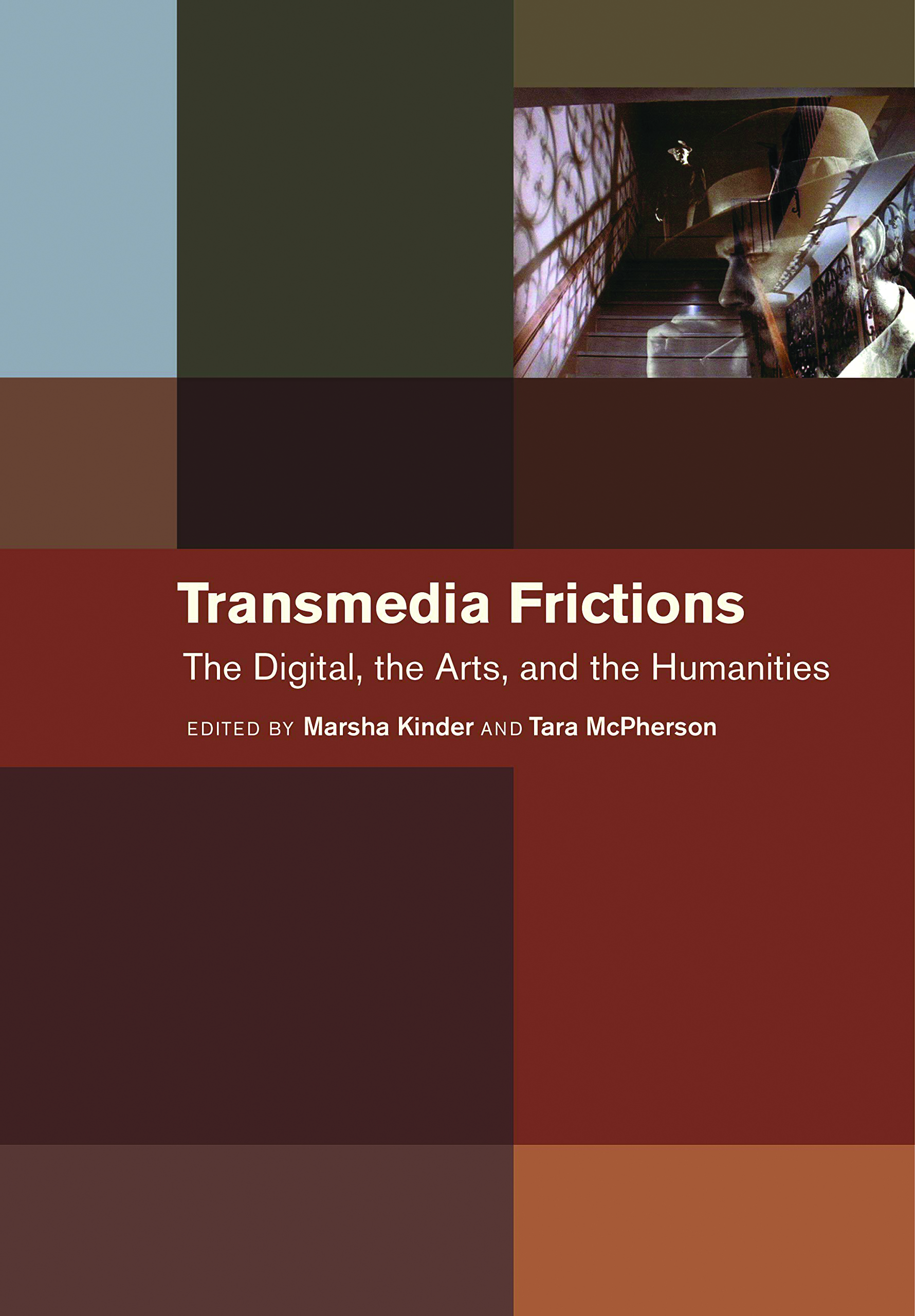 Transmedia Frictions: The Digital, the Arts, and the Humanities presents a collection of 17 varied essays, in two sections identified as “Part I. Medium Specificity and Productive Precursors” and “Part II. Digital Possibilities and The Reimagining of Politics, Place, and the Self”. The editors begin each section with a self-written introduction with the essay topics centering on theories surrounding digital humanities, which include multimedia, film, music, and the performing arts.
Transmedia Frictions: The Digital, the Arts, and the Humanities presents a collection of 17 varied essays, in two sections identified as “Part I. Medium Specificity and Productive Precursors” and “Part II. Digital Possibilities and The Reimagining of Politics, Place, and the Self”. The editors begin each section with a self-written introduction with the essay topics centering on theories surrounding digital humanities, which include multimedia, film, music, and the performing arts.
The original hardback version of this book was published in 2014. The authors were asked to revisit their original essays because of the passage of time and the nature of technology at the time of the original publication. However, the paperback version published in 2021, despite another significant time passage, sees the essay content still not updated.
The shortsightedness in not updating the essays, especially since those essays that make references to outdated technology, such as CD-ROM, the now defunct Myspace, and even DVDs are going to the wayside with the emergence of streaming television, yet the content also makes references to technology that is still used such as Augmented Reality (AR) and Virtual Reality (VR). As David Wade Crane in his prologue to the 2013 essay, “Linkages: Political Topography and Networked Topology”, puts it “despite its anachronisms, I don’t think it’s [the essay] now just and archaeological relic. Its references may be ‘outdated,’ but the dynamics it addresses are still in force. Perhaps more so” (p. 211). Similarly other theories presented within Transmedia Frictions are still sound, including theories on cultural politics, race, globalization, and ideas such a digital apartheid and other digital divides.
While some may seem outdated, other essays seem to have foretold the importance of technologies on our current reality, such as Caroline Bassett’s “Is This Not a Screen? Notes on the Mobile Phone and Cinema” where she discusses the importance of the screen on phones and their emergence as the preferred camera, despite their limitations at the time, emphasizing the idea that the best camera is the one you’ve got. Of course, today camera smart phone technology is staggering.
Today the value of Transmedia Frictions is on both the historical analyses presented as well as the theories and ideologies, careful consideration should be taken by the reader to reflect how these topics still effect the study of digital humanities. Like any collection of essays, the writing varies from easily digestible to quite dense and demanding, this book is intended for serious scholars of digital arts and humanities and how these technologies affect culture.
Amanda Horton
Amanda Horton holds an MFA in Design and currently teaches graduate and undergraduate courses at the University of Central Oklahoma (UCO) in the areas of design history, theory, and criticism. She is also the director of the Design History Minor at UCO.
About Us: Essays from the Disability Series of The New York Times
Peter Catapano and Rosemarie Garland-Thomson, eds. 2021. [ISBN 978-1-63149-858-9. 286 pages. US$18.95 (softcover).]
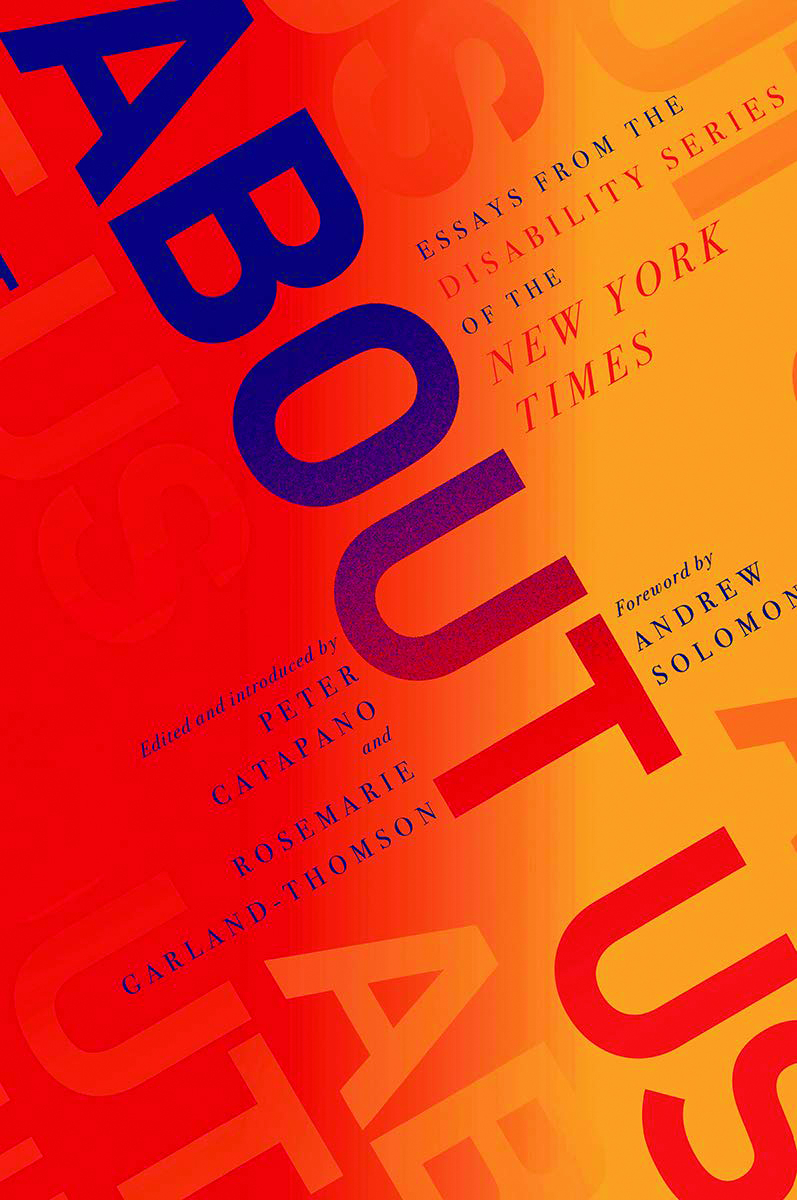 It is obvious that usability and accessibility drive technological innovation and advancement. Not so conspicuous is the source of this usability. For example, many are surprised to hear that the original touchscreen technology of the iPhone was purchased by Apple’s Steve Jobs in 2005 from an electrical engineering student sustaining injuries that interfered with his ability to study and work. Many do not know that the updated kitchen products engineered by the Oxo were the original design of a woman unable to work in the kitchen due to her arthritis. A Nuremberg-based watchmaker, also a paraplegic, created the first self-directed wheelchair which was the precursor to the modern bicycle. Or that curb cuts originated with disgruntled wheelchair users in Berkeley, CA. Later curb cuts became universal because they helped strollers, bicycles, baggage handlers, and anybody else navigating wheels.
It is obvious that usability and accessibility drive technological innovation and advancement. Not so conspicuous is the source of this usability. For example, many are surprised to hear that the original touchscreen technology of the iPhone was purchased by Apple’s Steve Jobs in 2005 from an electrical engineering student sustaining injuries that interfered with his ability to study and work. Many do not know that the updated kitchen products engineered by the Oxo were the original design of a woman unable to work in the kitchen due to her arthritis. A Nuremberg-based watchmaker, also a paraplegic, created the first self-directed wheelchair which was the precursor to the modern bicycle. Or that curb cuts originated with disgruntled wheelchair users in Berkeley, CA. Later curb cuts became universal because they helped strollers, bicycles, baggage handlers, and anybody else navigating wheels.
It is these inspirational stories with which we can relate and that make About Us: Essays from the Disability Series of The New York Times so relevant to the technical world. And yet beneath the inspirational stories of life-changing technology, there is humanity—heartache, struggle, alienation, and loneliness. The challenges with daily problems and the striving to maintain an outlook of positivity are also relevant to the technical world.
In this collection, editors Peter Catapano, Opinion Editor for the New York Times, and Rosemarie Garland-Thomson, disabled English professor at Emory University, compiled about 60 essays from the New York Times’ groundbreaking series on disability. Their intent was to include a wide variety of people—different ages, disabilities, outlooks, and experiences. Their goal of inclusion is explained, “By ensuring that people with disabilities tell their own stories, we intend to avoid and counter the sort of biased, simplified, often demeaning portrayals of them that are produced by an American popular culture designed by and for the nondisabled” (p. xx).
These essays, first published starting in August 2016, are organized in seven sections: justice, belonging, working, navigating, coping, love, family, and joy. By sorting experiences according to these topics, three overall disability challenges are conveyed: inherent challenges, access challenges, and social challenges. Underlying all this is the idea that the American Disabilities Act (ADA) of 1990, while progressive in many ways, was just a small step forward in necessary changes required for people of all disabilities to be integrated into our society. Mentioned at least twice throughout the text is the offensive 1927 Supreme Court decision in which Oliver Wendell Holmes declared, “It is better for all the world, if instead of waiting to execute degenerate offspring for crime, or to let them starve for their imbecility, society can prevent those who are manifestly unfit from continuing their kind. Three generations of imbeciles are enough” (p. ix). That such a statement was ever made in such a context demonstrates misguided public opinion both past and present.
These first-hand accounts of experiences and obstacles in the lives of disabled people open a glimpse into their worlds. It is through these rare glimpses that we can hope to bridge more of the gap between what the American Disabilities Act aimed to achieve and the realities of change and progress in our increasingly technological world.
Julie Kinyoun
Julie Kinyoun is an on-call chemistry instructor at various community colleges in Southern California. An avid reader, she enjoys reviewing books that help her become a better educator.
Writing the Novella
Sharon Oard Warner. 2021. University of New Mexico Press. [ISBN 978-0-8263-6255-1. 226 pages, including index. US$19.95 (softcover).]
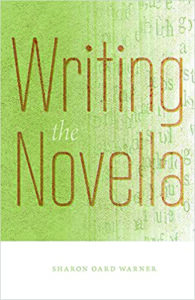 Among the hundreds of craft books on creative writing, from novels and short stories to creative nonfiction to various craft aspects like character and plot, only a few focus on the novella, and only one—Warner’s book, Writing the Novella—teaches how to write novellas using an amazing range of examples and exercises. Warner starts where readers might expect, by defining the novella as more than just a short novel or long story, and then she deconstructs the novella form while guiding readers through writing a novella. The book does an excellent job of not only introducing the novella form but also teaching readers how to write fiction—regardless of form.
Among the hundreds of craft books on creative writing, from novels and short stories to creative nonfiction to various craft aspects like character and plot, only a few focus on the novella, and only one—Warner’s book, Writing the Novella—teaches how to write novellas using an amazing range of examples and exercises. Warner starts where readers might expect, by defining the novella as more than just a short novel or long story, and then she deconstructs the novella form while guiding readers through writing a novella. The book does an excellent job of not only introducing the novella form but also teaching readers how to write fiction—regardless of form.
Any discussion of the novella must first begin with scope. What is a novella? Who decides? Is there any agreement? Warner provides several definitions of length, such as John Gardner’s 30,000–50,000 words; Mary Doyle Springer’s more generous 15,000–50,000; to the widest 10,000–60,000 set by Melville House (p. 7). Instead of taking a definitive step herself, she references the sources when referring to a work as a novella. For example, “At 49,445 words, The Great Gatsby (1925) just squeezes under the fence set by Springer and Gardner but has room to spare using the Melville House definition” (p. 8). Immediately following the discussion on length, she reveals her own definition; a novella should have a single idea, be set in a specific location over a short time, contain a few characters, and follow a “restricted” point of view.
Given this framework for the novella, Warner reviews the stories and techniques used in three exemplars: Ethan Frome by Edith Wharton, The House on Mango Street by Sandra Cisneros, and Fahrenheit 451 by Ray Bradbury, although throughout the book she refers to dozens of other stories.
Each chapter explains something of the craft of writing (story structure, character, plot, scene, and so on) with an emphasis on how they work in novellas. Since Warner frequently contrasts the novella to short stories and novels, readers can apply this craft information to other narrative forms. At the end of each chapter are journaling topics and “time to write” exercises that, in Part 1, help readers plan their novella and, in Part 2, write the draft. The book concludes with a detailed list of novellas and a useful list of places that publish novellas.
Writing the Novella is easy to read through, and Warner’s witty personality pokes through occasionally, but to get a novella out of this text, readers should read the three exemplars (if they haven’t) plus at least one or two other novellas and then slowly work through each chapter along with the journaling and exercises. The 15 chapters function as weekly topics in a semester of a Master of Fine Arts program—one with a caring, funny, and expert instructor.
Kelly A. Harrison
Kelly A. Harrison, MFA, teaches technical communication at Stanford University. Formerly, she taught a range of writing courses at San José State University and wrote for various high-tech companies. Kelly is the Associate Editor for West Trade Review.
You Are Here: A Field Guide for Navigating Polarized Speech, Conspiracy Theories, and Our Polluted Media Landscape
Whitney Phillips and Ryan M. Milner. 2021. The MIT Press. [ISBN 978-0-262-53991-3. 266 pages, including index. US$22.95 (softcover).]
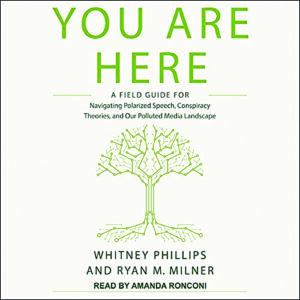 If we are ever going to get our democracy back on track and recover from extreme political polarization and the flood of disinformation and other toxic sludge that fuels it, we will need to gain a much better understanding of our troubled information environment than many of us now have.
If we are ever going to get our democracy back on track and recover from extreme political polarization and the flood of disinformation and other toxic sludge that fuels it, we will need to gain a much better understanding of our troubled information environment than many of us now have.
Taking its title from those trailside maps that help us locate ourselves in confusing environments, You Are Here: A Field Guide for Navigating Polarized Speech, Conspiracy Theories, and Our Polluted Media Landscape helps us understand the interlocking complexities of our polluted information ecosystem. Clearly written and brilliantly reasoned, the resulting analysis reaches further, dives deeper, and shines more light into overlooked places than we are likely to encounter elsewhere.
Whitney Phillips and Ryan M. Milner argue that we are amid a “network climate change” (p. 36). New technologies that facilitate creating, copying, and manipulating content, aided by platforms that encourage and monetize unlimited sharing, have greatly increased the speed and reach of information. When polluted content, whose true source often cannot be identified, flows across communities and international borders it can do a lot of real-world harm.
While active polluters—“white nationalists and supremacists, clickbait sensationalists, state-sponsored propagandists, and unrepentant chaos agents” (p. 6)—pump out a great deal of muck, they are only part of the problem. Pollution from sources that aren’t obviously toxic—citizens sharing a rumor about a pandemic and journalists point-by-point debunking it—can also do harm.
Polluted information owes much of its toxicity to human psychology. The mind uses deep memetic frames to make sense of what it sees (or thinks it sees), and these frames can lock us into thinking patterns and political positions that defy refutation by opposing facts. To illustrate, the authors trace how an age-old satanic subversion narrative undergirds recurring conspiracy theories such as the satanic panics of the 1980s, Pizzagate, and QAnon today.
The roles played by Internet culture, free-speech fundamentalism, blindness to possible harm, and many other factors are also addressed.
Turning their attention to remedies and mitigations, Phillips and Milner offer a valuable, nuanced critique of the limitations of the currently favored approaches—aggressive “fact” checking and media literacy—and advocate that we move beyond these to what they call “ecological literacy” (p. 149), a fuller understanding of how the information environment is networked, and how our actions reverberate to produce help or harm. From this broader perspective, the authors invite us to choose our own “ethics adventure” (p. 181) and offer several suggestions for how we might act strategically from wherever we are situated. At the very least, we can be aware of downstream harm, and be mindful about what we choose to share, challenge, or ignore.
Anyone who is seriously concerned with the fate of our democracy and the problems of our troubled information environment will find much of value here.
Patrick Lufkin
Patrick Lufkin is an STC Fellow with experience in computer documentation, newsletter production, and public relations. He reads widely in science, history, and current affairs, as well as on writing and editing. He chairs the Gordon Scholarship for technical communication and co-chairs the Northern California technical communication competition.
The Business of We: The Proven 3-Step Process for Closing the Gap Between Us and Them in Your Workplace
Laura Kriska. 2021. HarperCollins Leadership. [ISBN 978-1-400-21680-2. 292 pages, including index. US$19.99 (softcover).]
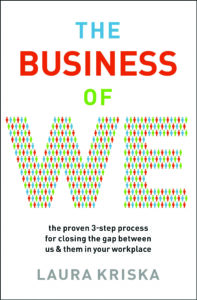 The engaging, readable The Business of We: The Proven 3-Step Process for Closing the Gap Between Us and Them in Your Workplace offers practical advice for our times, when we are frequently interacting with people from many different backgrounds and cultures and when we are increasingly aware of the challenges of collaboration and the risks of getting it wrong. Laura Kriska challenges us to understand that it’s not enough to work alongside people from different backgrounds and cultures. It’s not enough to proclaim that everyone is welcome or to “treat everyone the same.” We must recognize the gaps that exist and make concerted efforts to reach across and close them.
The engaging, readable The Business of We: The Proven 3-Step Process for Closing the Gap Between Us and Them in Your Workplace offers practical advice for our times, when we are frequently interacting with people from many different backgrounds and cultures and when we are increasingly aware of the challenges of collaboration and the risks of getting it wrong. Laura Kriska challenges us to understand that it’s not enough to work alongside people from different backgrounds and cultures. It’s not enough to proclaim that everyone is welcome or to “treat everyone the same.” We must recognize the gaps that exist and make concerted efforts to reach across and close them.
Kriska argues that we need to be aware that our institutions invariably have Us-versus-Them divisions. We need to recognize “WE-building” (p. 15) as a deliberate choice in which to commit to if we want to avoid the damage that we can inadvertently cause to individuals, projects, and organizations. With this approach, The Business of We is not only aimed at organizational leaders or managers, but at everyone. She emphasizes that we all have a responsibility to develop our “cultural intelligence” and to apply it in every encounter.
The book offers various tools to help us to lead or participate in these changes. For example, the “Cross-Cultural Continuum” (p. 29) helps us think about the impacts of cultural misunderstandings or blind spots. Certain behaviors or actions might have minimal negative impact and might not require any interventions. Likewise, certain well-intentioned efforts might have minimal positive impact; the continuum helps us to think about how to move past safe, low-impact actions and develop truly game-changing solutions.
Another chapter offers a set of awareness-building exercises including “iceberg stories” and “identity clouds” (pp. 118-122). There’s also an “Us versus Them” self-assessment (pp. 134-155) that measures the level of inter-connections that you may have with people from another cultural group. The Business of We discusses executive-level interventions such as employee resource groups, recognition programs, and equitable pay policies, as well as individual actions, such as WE-building communication tips. Kriska shows us that even small talk can create patterns that create an Us-versus-Them environment. She provides a table of examples on small-talk comments that we can rephrase to not only avoid damage but also start bridging those gaps.
Finally, the book drives home the point that people who are in the majority culture must take the lead. Kriska provides another continuum from “Unaware and Oblivious” (pp. 220-222) to “Aware, Willing to Act, but Unsure” (pp. 227-230). For each of these challenges, she provides practical actions to help us move ourselves forward.
I recommend The Business of We to anyone who is leading or working within global or diverse teams and anyone who is in a company that is striving to improve collaboration. The practical tips can help you to lead change in your organization and to see how you can get involved in practical ways.
Laurel Beason
Laurel Beason is an STC member and board member of the North Texas Lone Star chapter. She has more than 25 years of experience in technical communication.
Build Your Cultural Agility: The Nine Competencies of Successful Global Professionals
Paula Caligiuri. 2021. Kogan Page Limited. [ISBN 978-1-78966-659-5. 200 pages, including index. US$29.95 (softcover).]
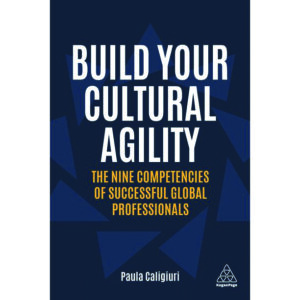 If you’ve ever changed your geographic, social, or employment context, you’ve changed cultures. Being able to recognize when the context changes and adapt rapidly (being culturally agile) is increasingly a survival skill. In Build Your Cultural Agility: The Nine Competencies of Successful Global Professionals, Paula Caligiuri provides a concise yet comprehensive summary of what you need to learn based on both broad experience and formal research.
If you’ve ever changed your geographic, social, or employment context, you’ve changed cultures. Being able to recognize when the context changes and adapt rapidly (being culturally agile) is increasingly a survival skill. In Build Your Cultural Agility: The Nine Competencies of Successful Global Professionals, Paula Caligiuri provides a concise yet comprehensive summary of what you need to learn based on both broad experience and formal research.
Caligiuri defines eight cultural dimensions we must master to achieve agility: formal vs. informal, egalitarian vs. hierarchical, individualist vs. group, transactional vs. interpersonal, direct vs. indirect communication, fluid vs. time-controlling, external vs. internal control, and balance vs. status. Many of these will be familiar. In the rest of the book, she defines nine competencies required to deal with these orientations. For example, tolerance of ambiguity (of uncertainty about how your context has changed) can be attained by listening, observing, asking questions, inviting feedback, delaying judgment, avoiding stereotyping, and aiming for consensus. The other competencies are curiosity (eagerness to learn), resilience (recovering from failures), humility (judging only once you fully understand), relationship-building, perspective taking, cultural adaptation (adopting new behavioral norms), cultural minimization (enforcing universal norms, such as safety regulations), and cultural integration (achieving consensus on norms among teammates from different cultures).
Rather than just describing agility, Caligiuri provides recommendations in each chapter about how to achieve it and recommends working on a manageable number of things simultaneously to avoid feeling overwhelmed. She provides frequent short self-tests to help you understand yourself and your needs, and correctly emphasizes the need for time, focus, practice, and the need to stretch one’s “muscles” gradually to avoid culture shock. The principles are generally clear, but although Caligiuri begins each chapter with a case study, more short, illustrative examples would have made many points less abstract.
The writing is generally clear, but Caligiuri’s nomenclature isn’t always obvious. She also occasionally falls into jargon like “to onboard a new member” (p. 25); “to pre-mortem” (p. 71); “train on the expectation of subjective norms” (p. 155); and “to exit those who are not behaving” (p. 157). She repeatedly mentions one’s genetic characteristics (p. 32), hormones (p. 62), limbic system (p. 148), and prefrontal cortex (p. 149). This seems, at best, misplaced and overly deterministic. There are also curious omissions, such as waiting until pages 38 and 42 to recommend learning the culture’s language and social conventions before entering the culture.
Though there’s no substitute for experiencing a new culture, Building Cultural Agility provides great preparation before you dive in. Though intended primarily for business readers, the book will help in other contexts, including tourism and working in interdisciplinary teams.
Geoff Hart
Geoff Hart is an STC Fellow with more than 30 years of writing, editing, translation, and information design experience. He’s traveled widely and worked with authors from many cultures. He’s the author of two popular books, Effective Onscreen Editing and Writing for Science Journals.
The Corporate Terminologist: Terminology and Lexicography Research and Practice
Kara Warburton. 2021. John Benjamins Publishing Company. [ISBN 978-90-272-0849-1. 250 pages, including index. US$149 (hardcover).]
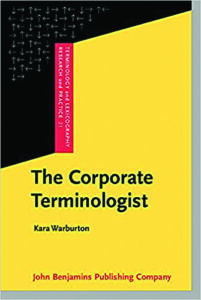 Kara Warburton’s The Corporate Terminologist: Terminology and Lexicography Research and Practice describes the benefits and methods of terminology management in corporations. Before reading this book, my only exposure to corporate terminology were a few LinkedIn conversations asking for community input on the topic. But, as Warburton points out, the practice of terminology is not new. What is new is the adoption of this practice to the private sector.
Kara Warburton’s The Corporate Terminologist: Terminology and Lexicography Research and Practice describes the benefits and methods of terminology management in corporations. Before reading this book, my only exposure to corporate terminology were a few LinkedIn conversations asking for community input on the topic. But, as Warburton points out, the practice of terminology is not new. What is new is the adoption of this practice to the private sector.
The Corporate Terminologist is specifically written with the private sector in mind. Warburton identifies where conventional terminology methods and practices diverge for corporations. To that end, she organized the book into four parts: Foundations of terminology, commercial terminography, planning a corporate terminology initiative, and implementing and operating the termbase.
Warburton establishes the value of terminology to corporations when she says that terminology can “increase employee productivity, reduce production costs, reduce time-to-market, and increase customer satisfaction” (p. 42). Such objectives make it clear that there are benefits both to employees, particularly writers and translators, as well as to the corporations that employ them. I felt that Warburton wrote The Corporate Terminologist mostly with large corporations in mind. While the information provided is useful to all corporations, I felt that smaller corporations might experience a different path to establishing a terminology management program. For instance, smaller corporations might implement a termbase within a team or department to test methods and practices before working through a detailed proposal. Warburton even acknowledges that corporate terminology is “uncharted territory” and that this book is meant to “raise awareness of the terminology discipline” (p. 230).
If you’re looking to establish a system for managing terminology in the private sector, Warburton does a wonderful job of introducing all the basic concepts, identifying how terminology management can benefit corporations, and providing methods for building a terminology program that works for you.
Sara Buchanan
Sara Buchanan is an STC member and a content strategist at LCS in Cincinnati, OH. In her free time, she’s an avid reader, enjoys cooking, and doting on her cats: Buffy and Spike.
Global Health: Ethical Challenges
Solomon Benatar and Gillian Brock, eds. 2021. 2nd edition. Cambridge University Press. [ISBN 978-1-108-72871-3. 510 pages, including index. US$64.99 (softcover).]
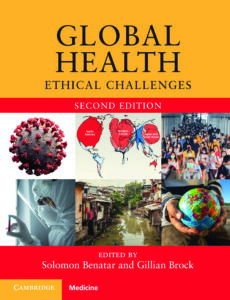 It is difficult to know where to begin with my review of the second edition of Global Health: Ethical Challenges. I had no idea what I was in for when reading this book in terms of learning what global health is, what it is connected to, and the many controversies surrounding this topic. The sheer comprehensiveness of the book is one of its many strong points. It is an anthology of global contributors with 38 chapters divided into six sections: definitions and descriptions; ethics, responsibilities, and justice; poor health responsibilities; environmental/ecological considerations; cross-cultural perspectives; and shaping the future. Each chapter, although uniquely written, covers 1) how we exacerbate poor global health; 2) what we should do about it; and 3) why we should do something about it. The learning curve from this book is immense and one that is applicable to professionals in all disciplines.
It is difficult to know where to begin with my review of the second edition of Global Health: Ethical Challenges. I had no idea what I was in for when reading this book in terms of learning what global health is, what it is connected to, and the many controversies surrounding this topic. The sheer comprehensiveness of the book is one of its many strong points. It is an anthology of global contributors with 38 chapters divided into six sections: definitions and descriptions; ethics, responsibilities, and justice; poor health responsibilities; environmental/ecological considerations; cross-cultural perspectives; and shaping the future. Each chapter, although uniquely written, covers 1) how we exacerbate poor global health; 2) what we should do about it; and 3) why we should do something about it. The learning curve from this book is immense and one that is applicable to professionals in all disciplines.
Global Health is an example of a truly interdisciplinary work that demonstrates the multidimensional complexity of global health. This one text is applicable to a variety of workplace environments and courses including philosophy, economics, environmental science, technical communication, global studies, cultural studies, gender studies, and so much more. Each chapter addresses head on the disparities of global health, explores the depth and breadth of what global health means and what influences health and well-being, and dispels the seemingly easy fixes that are part of national, sometimes global, controversies and debates. For instance, the commonly held belief that globalization is a positive factor in improving global health is disputed in several chapters with substantial research, philosophical reasoning, and real-world examples as support. The idea that if countries grow economically then health will naturally follow is analyzed in detail and readers are provided with arguments that expose them to the intricate and expansive field of global health.
It is asserted throughout the book that health is a human right. Although that argument seems straight-forward enough, what makes it a contested argument is that health extends beyond the biomedical. There are many factors that determine health and well-being, factors that are national and global issues themselves, including access to and distribution of health facilities, goods, and services, essential food, shelter, sanitation, and safe water to name just a few. It was incredibly mind-opening to see how national debt, arms trade, politics, ecology, and a multitude of social determinants all relate directly to health. Global Health was written before COVID-19 so it does not provide a comprehensive review of the implications and ramifications of the virus on global health; however, the book presents arguments about urgent issues at stake that need immediate attention, such as how “climate change could be the biggest threat to global health in the twenty-first century” (p. 284) because it threatens to affect “food price, famine, conflict, and mass migration” (p. 285). Although the book is immense, it is easily accessible, affordable, and highly recommended for upper-level undergraduates, graduates, and professional audiences from all disciplines.
Diane Martinez
Diane Martinez is an associate professor of English at Western Carolina University where she teaches technical and professional writing. She previously worked as a technical writer in engineering, an online writing instructor, and an online writing center specialist. She has been with STC since 2005.
Extra Bold: A Feminist, Inclusive, Anti-racist, Nonbinary Field Guide for Graphic Designers
Ellen Lupton, et al. 2021. Princeton Architectural Press. [ISBN 978-1-61689-918-9. 220 pages, including index. US$29.95 (softcover).]
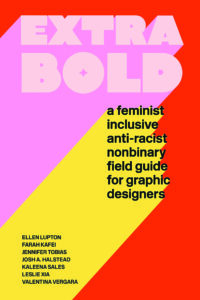 The subtitle says it all, Extra Bold is in fact the feminist, inclusive, anti-racist, non-binary field guide that designers have been looking for, and if they haven’t been looking, they should have been. This book is a collection of essays written by a collective of authors who come from a diverse range including women and men of color as well as authors who identify as non-gender conforming. Extra Bold is an excellent opportunity for practicing graphic designers, and anyone else who struggles with these topics, to better inform themselves about current issues in design. You don’t even have to be a designer to enjoy or be informed by the book.
The subtitle says it all, Extra Bold is in fact the feminist, inclusive, anti-racist, non-binary field guide that designers have been looking for, and if they haven’t been looking, they should have been. This book is a collection of essays written by a collective of authors who come from a diverse range including women and men of color as well as authors who identify as non-gender conforming. Extra Bold is an excellent opportunity for practicing graphic designers, and anyone else who struggles with these topics, to better inform themselves about current issues in design. You don’t even have to be a designer to enjoy or be informed by the book.
Extra Bold is broken into three sections that are identified as theory, history, and work. It is interesting to note that all headlines and titles throughout the book are set entirely in lowercase, this is explained as a nod to bell hooks, the Black feminist author and social activist, who uses lowercase letters to push back against patriarchal naming systems, similarly Extra Bold pushes back against traditional typographic hierarchies. Besides the well-written, informative essays, the book is also full of illustrations, diagrams, and infographics that support the text, which also sometimes serve as comic relief, something that is welcome in a book full of very heavy subjects. One example is an infographic by Kim Goodwin on page 35 that does an excellent job of helping users identify if they are “mansplaining” or not. For those who tend to get ‘splained to, they can share this helpful graphic with the ‘splainers (p. 34).
The book tackles serious subjects but explains them in a way that is very accessible. Besides the diverse group of authors, Extra Bold also includes interviews from designers and design students about their personal industry experiences. In an insightful interview with Tré Seals he remarks, “I realized that when a single gender and race dominates an industry, there can only be (and has been) one way of thinking, teaching, and creating” (p. 76). Extra Bold also contains helpful tips for anyone on how to come out at work, or to share your pronouns in the workplace. Additionally, Extra Bold goes beyond issues of gender and race to include information about design and (dis)ability.
If you are still wondering if this book will be right for you, consider this, it will be useful to practicing designers and students who are looking to navigate the changing world of design around them. It will also be useful to instructors who wish to find ways to have difficult discussions regarding race, inclusivity, and gender in the classroom. Or perhaps you thought that these are issues that don’t affect design, if so then you might need to read the book twice. After all, as the authors remind us, “Eurocentric principles of modern design were conceived as egalitarian tools of social progress, yet they served to suppress differences among people across the globe” (p. 9).
Amanda Horton
Amanda Horton holds an MFA in Design and currently teaches graduate and undergraduate courses at the University of Central Oklahoma (UCO) in the areas of design history, theory, and criticism. She is also the director of the Design History Minor at UCO.
Becoming a Writer, Staying a Writer: The Artistry, Joy, and Career of Storytelling
- Michael Straczynski. 2021. BenBella Books. [ISBN 978-1-950665-88-4. 230 pages, including index. US$17.95 (softcover).]
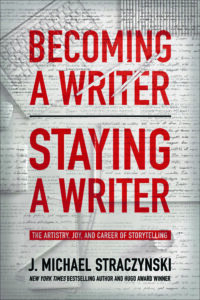 What is it like to write for a living? Michael Straczynski addresses this question in part in Becoming a Writer, Staying a Writer: The Artistry, Joy, and Career of Storytelling. He also addresses the question of why people write when he quotes Stephen King as King notes, “You do it because to not do it is suicide” (p. 2).
What is it like to write for a living? Michael Straczynski addresses this question in part in Becoming a Writer, Staying a Writer: The Artistry, Joy, and Career of Storytelling. He also addresses the question of why people write when he quotes Stephen King as King notes, “You do it because to not do it is suicide” (p. 2).
Straczynski also notes that he has “been fortunate enough to make a living as a writer for over forty years” (p. 1) so seeing what he has to say in Becoming a Writer, Staying a Writer should provide valuable insight. For example, Straczynski notes in the section on staying a writer that the Three Legged Stool Theory can help as the writer should always have “at least three streams of revenue, and three forms of creative expression” to survive as a writer (p. 196). Straczynski continues that when he first started out as a writer, he worked on newspaper articles, fiction, and radio.
If you wonder what it can be like to write for a living outside of technical writing, or besides technical writing, Becoming a Writer, Staying a Writer provides some insight. Straczynski addresses the young writer in the first part of the book on becoming a writer and includes a chapter to the college or university student. In the second part, he addresses the person who is already established as a writer and what that writer can do to stay employed and working successfully in the field. The book also includes a section on writer’s block as Straczynski says it does not exist.
Jeanette Evans
Jeanette Evans is an STC Associate Fellow; active in the Ohio STC community, currently serving on the newsletter committee; and co-author of an Intercom column on emerging technologies in education. She holds an MS in technical communication management from Mercer University.
Media Technologies for Work and Play in East Asia: Critical Perspectives on Japan and the Two Koreas
Micky Lee and Peichi Chung, eds. 2021. Bristol University Press. [IBSN 978-1-5292-1336-2. 296 pages, including index. US$105.00 (digital).]
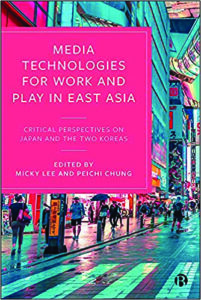 As the COVID-19 pandemic drags on and continues to change the way we work, study, and play, Media Technologies for Work and Play in East Asia: Critical Perspectives on Japan and the Two Koreas is a timely riveting page-turner if you are interested in technical communication studies, cultural studies, game studies, or political economy and trying to answer this question: how work and play are (re)defined through technology-mediated interactions in the emerging techno-cultural spheres of Northeast Asia?
As the COVID-19 pandemic drags on and continues to change the way we work, study, and play, Media Technologies for Work and Play in East Asia: Critical Perspectives on Japan and the Two Koreas is a timely riveting page-turner if you are interested in technical communication studies, cultural studies, game studies, or political economy and trying to answer this question: how work and play are (re)defined through technology-mediated interactions in the emerging techno-cultural spheres of Northeast Asia?
It is considerably challenging to tackle this question, but the editors smartly crack it by focusing on three themes: gender and sex online, digital media governance and regulations, and techno-identity and digital labor condition. Under this thematic framework, the editors break this big question into five parts: (1) How does digital technology change labor practices and industry structure through gameplay? (2) How does play foster sociality in a corporation-dominated digital environment? (3) How does digital technology foster meanings of work and play? (4) What new meanings do concepts such as intellectual property, data privacy, and sociality have in these countries? (5) How is the idea of region created via media contents?
The three themes make up the book’s three chapters, of the book, which is an explicit organizational method. The five thematic questions work as the implicit organizational method since they appear in each chapter and remind the audience of the “politically-contested and richly contextualized” nature (p. xii) of technology-mediated work and play shaped by local and regional cultures.
This is the most interesting thing about Media Technologies for Work and Play in East Asia: it progresses from the academic dialogue about transnational communication to a more grounded level to make sense of the cultural connections between Northeast Asia and the West. Cultures are part of the user experience. This book proves this point not by comparing Northeast Asia to the West, but by examining the local practice where new meanings and features emerge. For example, chapter one contextualizes digital gender in Northeast Asian collectivist culture and patriarchal social relations. It shows that while e-commerce and digital gaming users experience different gender expressions and challenge gender relations, the offline gender reality constrains online gender experience. Chapter two discusses whether regulations can control technologies or not. It finds out a fear for technology in regulations as “technologies are believed to eradicate a respect for the collective when members indulge in too many individual activities” (p. 99). Chapter three presents three new techno-cultural spheres: esports, robot therapy, and pachinko, which yield new labor productivity and transformation and further lead to new identity transformation.
The three countries in this region, Japan and the two Koreas, have been culturally related yet politically contentious both in the past and in the present, generating in them a myriad of user cultures mediated by this specific regional background. Contextualizing global technology diffusion in such a region is essential to understand technical communication in transcultural contexts. The unique ecology of media technologies for work and play deserves our attention. The insights from Media Technologies for Work and Play in East Asia also can be applied and extended to other societies.
Lin Dong
Lin Dong, PhD, is a lecturer who teaches Professional and Technical Writing at the School of International Studies in the University of International Business and Economics, Beijing, China. She won the Best Paper Award at 2020 IEEE ProComm Conference.
Advanced Creative Nonfiction: A Writer’s Guide and Anthology
Sean Prentiss and Jessica Hendry Nelson. 2021. Bloomsbury Publishing. [ISBN 978-1-350-06780-6. 334 pages, including index. US$30.95 (softcover).]
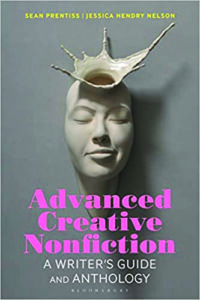 Many texts on how to write creative nonfiction (CNF) mimic the craft lessons for fiction, for example, covering plot, setting, character development, and so on. Others consider only the essay, while some address only a handful of forms or subgenres like memoir and travel writing. Advanced Creative Nonfiction: A Writer’s Guide and Anthology sets a new standard for teaching creative nonfiction by covering a wide range of craft topics, explicating old and emergent forms, and including a unique anthology.
Many texts on how to write creative nonfiction (CNF) mimic the craft lessons for fiction, for example, covering plot, setting, character development, and so on. Others consider only the essay, while some address only a handful of forms or subgenres like memoir and travel writing. Advanced Creative Nonfiction: A Writer’s Guide and Anthology sets a new standard for teaching creative nonfiction by covering a wide range of craft topics, explicating old and emergent forms, and including a unique anthology.
The book has two parts, craft and anthology. Fifteen chapters on craft cover subjects from the history of CNF to dramatic design, from phenomenal truths to ethics and credibility. Each craft chapter begins with a list of readings from the anthology that exhibit the qualities of craft covered in the chapter. Next, a vignette demonstrates some aspect of the craft, a scene or an excerpt written by either of the two authors. The vignette is then discussed in the core of the chapter alongside the craft.
After this core information comes a section called “Reading as a Writer,” with typically three exercises connecting the craft to works in the anthology, and another section, “prompts,” for practicing the craft. This structure lends itself to the typical 15-week semester, making this an ideal organization for upper-division or graduate courses.
Early on, the Advanced Creative Nonfiction establishes how a writer functions: “as an explorer, a map-maker, a diver into deep waters of memory and experience” (p. 40). No matter the form, CNF writers ask, “what and why we want to know about” (p. 39) the subject of the writing. That writing is treated as an active process of exploring, discovering a central question but also finding an answer, what the authors call the knot of meaning—something a reader can make their own.
Prentiss and Nelson’s approach is not to examine the product’s elements (the essay, the memoir, and so on) so much as to focus on the active work of writing, demystifying that work for those learning the trade, and this is one way the text sets a new standard in creative writing texts. Each chapter reads as an engaging lecture, a lesson on how to process, and more importantly, how to be a human who writes.
The book’s second part is an anthology of 26 works that defy summary—poetry, found stories, erasure, a play, graphical stories. The anthology alone is worth the purchase.
Most textbooks these days also have a companion website, and this one (http://www.bloomsburyonlineresources.com/advanced-creative-nonfiction) consolidates definitions of all terms (sorted both alphabetically and topically). The authors also created a podcast wherein they converse with authors from the anthology, but some of the episodes were recorded with substandard sound quality, this is, they weren’t recorded in a studio. Still, the discussions I listened to were engaging, and they offer curious writers a glimpse into the type of material covered in this text.
Kelly A. Harrison
Kelly A. Harrison, MFA, teaches technical communication at Stanford University. Formerly, she taught a range of writing courses at San José State University and wrote for various high-tech companies. Kelly is the Associate Editor for West Trade Review.
The Artful Dickens: The Tricks and Ploys of the Great Novelist
John Mullan. 2020. Bloomsbury Publishing. [ISBN 978-1-4088-6681-8. 448 pages, including index. US$28.00 (hardcover).]
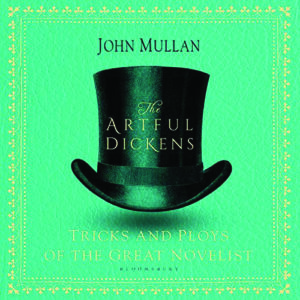 The work of Charles Dickens has been read, reviewed, analyzed, and criticized. But, according to John Mullan, many who have written about him have not answered the question, “What is so good about Dickens’s novels?” (p. 1). The Artful Dickens: The Tricks and Ploys of the Great Novelist is his answer.
The work of Charles Dickens has been read, reviewed, analyzed, and criticized. But, according to John Mullan, many who have written about him have not answered the question, “What is so good about Dickens’s novels?” (p. 1). The Artful Dickens: The Tricks and Ploys of the Great Novelist is his answer.
Mullan answers his own question in each chapter by pointing out characteristics of Dickens’s novels that made his work not only popular but good. Chapter titles include “Laughter,” “Speaking,” “Foreshadowing,” and “Smelling.’’ Dickens was an experimenter. His writing may not have been as refined as that of his contemporaries, but his “special mix of unliterariness and formal daring,” (p. 3) while criticized by others as faults, pleased his readers. Dickens simplified first impressions of characters, seeing them from the outside, rather than delving into their psychology. He moved between present and past tense within the same chapter and the same novel. He developed new forms of writing, such as the ghost story. He invented names that have entered the English language and are still in use today. He found the humor in almost every situation, even the most frightening. He invented words. He allowed his characters to speak in the hyperbole of everyday speech. Of all these “tricks and ploys,” Mullan believes the pattern of repetition, “an audacious poetry of repetitiousness,” (p. 391) that pervades Dickens’s prose is “the very essence of Dickens’s style” (p. 389).
The Artful Dickens includes many excerpts from Dickens’s novels to illustrate the author’s points. If there is not an excerpt, Mullan supplies a plot synopsis. These are in-depth examinations of the novelist’s prose by an expert. While a casual reader of Dickens may gain added insight into the novelist’s style, the many plot details from many novels interwoven with other information becomes somewhat intense and can detract from understanding the “goodness” of a particular characteristic. Someone with more extensive knowledge or study of Dickens and other Victorian novels would likely be the best audience for this book.
An analysis of a Victorian novelist’s work may not seem to contain technical communicator lessons. But we can learn from Charles Dickens and from The Artful Dickens. Two things stand out. First, Dickens knew and wrote for his audience, a cardinal rule for any communicator. Like many novels of the period, Dickens’s novels appeared in installments. He wrote each installment separately, and “was always feeling for the public’s responses” (p. 4). Second, he edited his text relentlessly, until it was time for it to be printed. His edits are visible in the manuscripts that still exist where Dickens “meticulously adjusts his diction and phrasing” (p. 11).
Mullan considers Dickens somewhat of an outlier among his contemporaries as well as a precursor to modern writers. The bibliography listing Dickens’s novels and other works referred to in The Artful Dickens provides a source for comparison.
Linda Davis
Linda M. Davis is an independent communications practitioner in the Los Angeles area. She holds an MA in Communication Management and has specialized in strategic communication planning, publication management, writing, and editing for more than 25 years.
How to Invent Everything: A Survival Guide for the Stranded Time Traveler
Ryan North. 2018. Riverhead Books [ISBN 978-0-7352-2014-0. 438 pages including index. US$27.00 (hardcover).]
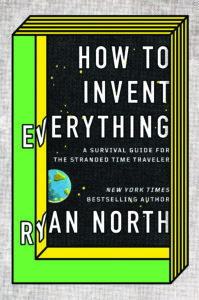 Time travel is a common and popular theme in both literature and film. From H.G. Wells to Back to the Future, people have imagined how time travel could work and alter their lives, perhaps by travelling to the past to make a sound investment or place a winning bet on a sporting event. However, very few sources center on travelling through time with the intention of inventing everything and explain to you how to do so. Humorist Ryan North, perhaps best known for his Dinosaur Comics, wears the hat of a technical communicator and presents a fun, but serious look at how to re-create the modern world if you are stranded in the past, in How to Invent Everything: A Survival Guide for the Stranded Time Traveler.
Time travel is a common and popular theme in both literature and film. From H.G. Wells to Back to the Future, people have imagined how time travel could work and alter their lives, perhaps by travelling to the past to make a sound investment or place a winning bet on a sporting event. However, very few sources center on travelling through time with the intention of inventing everything and explain to you how to do so. Humorist Ryan North, perhaps best known for his Dinosaur Comics, wears the hat of a technical communicator and presents a fun, but serious look at how to re-create the modern world if you are stranded in the past, in How to Invent Everything: A Survival Guide for the Stranded Time Traveler.
The book’s framing narrative is that you are a time traveler stranded in the past, reading the time machine repair guide. In the likely event that you cannot fix the time machine, you’ll have to build modern society from scratch, with the guide’s help. While this sounds fantastical in concept, it sets the tone for what is essentially a reference book on discovering everything, from breeding dogs from wolves, to creating charcoal to filter water, to composing “Ode to Joy” with your name on the manuscript.
In the introductions, North credits a technical writer (himself in another timeline) with creating the book’s content. Accordingly, much of the content is relatively technical in nature, although explained so any common person/stranded time traveler can follow along and understand. Each section lists the invention, a relevant quote about it, a description, what people did without it before it was invented, when it was invented, the prerequisites of inventing it, and how to invent it. For example, without inventing glass you would not have corrective lenses or microscopes. To invent it no prerequisite inventions are needed unless you want to make artificial glass. Next, not only instructions on how to create glass are provided, but also how to form glass into useful objects, such as a telescope. Footnotes help flesh out the process and add levity to the content.
After reading How to Invent Everything, you may not be ready to create a combustion engine from scratch, although all types of engines are described. Throughout what could be a dense encyclopedia of information, North sprinkles humorous observations and informative footnotes about actual history, such as the “wandering womb” theory from ancient Greece that persisted until the 1800s. The content reads like a high-level summary of what you would expect to learn in an overview course of just about everything, including basic chemistry to music composition to computer logic and the first 768 digits of pi for reference. For anyone who would like a general explanation of how the modern world works explained at a high school level, invent moveable type and bookbinding, pick up a copy of this book, warm up your flux capacitor, and prepare for a delightful travel through time.
Timothy Esposito
Timothy Esposito is the Manager of Logistics Documentation at Oracle, an STC Fellow, the STC Secretary, and a past president of the STC Philadelphia Metro chapter with more than 20 years of technical communication experience.
Creative Writing for Social Research: A Practical Guide
Richard Phillips and Helen Kara. 2021. Policy Press. [ISBN 978-1-4473-5598-4. 212 pages, including index. $47.95 (softcover).]
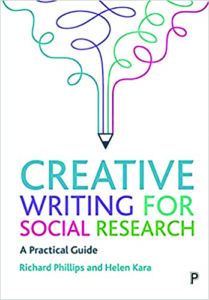 Connect with the heart and the head will follow. The return journey takes a little longer.
Connect with the heart and the head will follow. The return journey takes a little longer.
This is the idea behind Creative Writing for Social Research: A Practical Guide. It’s a daunting task since it often flies in the face of traditional scholarly conventions. Like, for example, citing in the text “(Smith, 2008).” Instead of Smith said this and Jones said that people like to know who Smith is, as in: “Economist Jayson Smith found that. . .” And the dozens of other examples of “academese.”
The authors emphasize that social researchers use creative writing in all aspects of their work, from exploring and analyzing data, to presenting and disseminating their findings. And they insightfully expand their definition of the term, to include a wide range of genres, such as: letters and stories, poems and diary entries, written dialogues and playscripts.
You can divide creative writing into two parts: One includes writing techniques like rhythm and repetition; figurative language and rhetorical questions; conversational language and changing the parts-of-speech of words (this one from Truman Capote: “There was a group of Australian army officers baritoning ‘Waltzing Matilda.’”)
The second is: dissecting the meaning of the word story. At its simplest, a story contains three elements: people, place, and plot (the 3 P’s): (1) People are interested in people; (2) the idea of place engages the physical senses; something important even for anchoring more abstract ideas; and (3) plot. And this is crucial: In academic and scholarly writing, you can think of plot as the thesis or hypothesis: the theme you are pursuing throughout the written piece; the major thread that runs throughout it.
Some problems? The authors succumb to academic jargon; words like polyvocal, polytextual, and polygraphical (p. 11). They compare creative writing with social research, that they refer to as its “canonized counterpart” (p. 3). “They mention two researchers who collaborated in an autoethnographic piece. . .” (p. 67). Yet far less jargon than scholars tend to use.
Just one unforgivable item: a 48-line paragraph on page 14. Optimal length for a paragraph is 10-15 lines maximum; the best length for understanding and remembering.
The authors do finally make an irresistible case for using creative writing in social research (p. 4):
“What is known in prose might be known differently in poetry.”
“Reaching larger and more diverse audiences than conventional research writing.”
Reaching readers emotionally . . . in ways that formal academic writing cannot.”
“Of course, the road to discovering often starts with definitions. “Reaching,” here can mean many things, such as understanding or remembering, and not least: enjoyment.
Steven Darian
Steven’s most recent books are Technique in Nonfiction: The Tools of the Trade (2019); The Wanderer: Travels & Adventures Beyond the Pale (2020); and The Heretic’s Book of Death & Laughter: The Role of Religion in Just About Everything (due out late 2021).
The Hum of the World: A Philosophy of Listening
Lawrence Kramer. University of California Press. [ISBN 978-0-520-38299-2. 244 pages, including index. US$22.95 (softcover).]
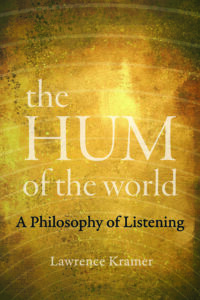 Lawrence Kramer’s The Hum of the World: A Philosophy of Listening contends that the “rise of digital technology” (p. 13) has so intensified the power of the visual that it obscures the central role of sound in how we know things. The visual both reduces “complex ideas . . . to cliché” (p. 13) and separates the observer from the observed, resulting in an alienated, superficial relationship to reality that can be resolved by reconnecting knowledge with sound.
Lawrence Kramer’s The Hum of the World: A Philosophy of Listening contends that the “rise of digital technology” (p. 13) has so intensified the power of the visual that it obscures the central role of sound in how we know things. The visual both reduces “complex ideas . . . to cliché” (p. 13) and separates the observer from the observed, resulting in an alienated, superficial relationship to reality that can be resolved by reconnecting knowledge with sound.
Sound is experienced as the audible, what we physically hear, but arises within a context Kramer dubs the “audiable”—the inserted “a” signifying what can be heard potentially rather than. In language, we sense the audiable when we know what we think, but cannot yet put into words. This audiable “pause” is also sensed through music, and simultaneously discloses “what we know about music” and “what music enables us to know” (p. 18).
The audiable reveals itself through a “sympathetic resonance” between the body and sound that “dissolves the distinction between subject and object” (p. 20), so that the “spirit becomes an object of sense” (p. 20) and reveals “the presence of a material body with spiritual resonance” (p. 176), but without relapsing into the ideological or religious dogma represented by the traditional “fatal alternatives of blind faith or blind empiricism” (p. 23).
Sympathetic resonance and awareness of the audiable occur because the body, like life itself, is primarily defined not only by how it looks, but also by how it sounds. “To be alive, the organs must be non-silent,” and must “therefore harbor the potentiality of resonance independent of any actual resonance. . .organs resound from the place of the audiable” (p. 200). A stethoscope reveals the “body as speaker” by amplifying “the body’s own voice, which is not its speaking voice” (p. 200), but rather the sounds of a beating heart, breathing lungs, and flowing blood.
A traditional metaphor for describing the audiable is the Aeolian harp, which produces sounds and tones when wind blows through its strings. The body is like an Aeolian harp. It resonates with the flow of potential sound carried by the wind and reconnects the listener’s body and consciousness with the audiable, or the “perceptible potentiality of sound” (p. 31), and the life force itself.
Kramer organizes The Hum of the World in neither a “chronological or topical arrangement (p. 2),” but rather as a musical composition with theme and variation, so that “certain themes keep returning, as they might in a piece of music” (p. 3), and the text can be read “consecutively or piecemeal, in no particular order” (p. 2). The book’s form mirrors its theme: like music, it mixes localized variations to reveal their underlying commonality, as varying passages in music are unified by a single key signature.
Kramer’s argument resembles Michael Polyani’s thesis that we can know more than we can tell, or as Kramer puts it, that we can “understand cognition apart from consciousness” (p. 77). Sound, language, and especially music testify to this epistemological principle, as does Kramer’s demanding, imaginative, and rewarding book.
Donald R. Riccomini
Donald R. Riccomini is an STC member and was a senior lecturer in English at Santa Clara University, where he specialized in engineering and technical communications. He previously spent twenty-three years in high technology as a technical writer, engineer, and manager in semiconductors, instrumentation, and server development.
Career Anxiety: Guidance Through Tough Times
Saul Carliner, Margaret Driscoll, & Yvonne Thayer. 2021. International Career Press. [ISBN 979-8-51958-589-7. 422 pages. US$9.99 (digital).]
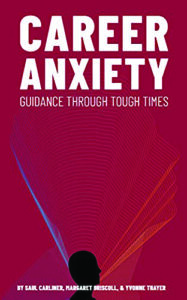 The world can be an unkind place for anyone forced to seek new employment in uncertain and changing times. If you are one of these people, Saul Carliner, Margaret Driscoll, and Yvonne Thayer have published a pragmatic handbook worth looking into.
The world can be an unkind place for anyone forced to seek new employment in uncertain and changing times. If you are one of these people, Saul Carliner, Margaret Driscoll, and Yvonne Thayer have published a pragmatic handbook worth looking into.
The targeted readers include technical communicators, although recommendations apply to other professionals as well. The authors’ first words in the preface set Career Anxiety: Guidance Through Tough Times as “a must-read for professionals and skilled workers approaching the middle and later stages of their careers.” It aims to help people within this demographic who are employed or who were recently employed “navigate what is anticipated to be an increasingly challenging job market and to plan for their long-term employability” (“Preface,” paras 1 and 6).
You’ll find the book’s structure easy to follow. Section I describes the wide-ranging changes that have occurred since the 1970s. The next section goes into how these changes affect employability and, in general, how to pursue jobs. More interesting and useful, in my opinion, is the final section, which offers many recommendations for maintaining employability once you’ve landed a job that you like.
Each chapter follows the pattern “what’s changed,” “what remains the same,” and “so what,” which offers specific points of advice. You won’t find cuteness or the overly familiar “best of 10” tone. Instead, you get several interesting points, including many I have seldom if ever seen discussed in books. For example, how can you approach employers if you have no college degree or the wrong one? What specific steps can you take to avoid problems in your “digital vapor trail”—things you’ve said online (“The Death of the Resume and the Changing ‘Paperwork’ of the Application Process,” para 7)? How should you proceed if you’re stuck in a job you dislike? Some lessons are taught through “fictional illustrations,” familiar to you as “personas.”
By far the most effective element is the 39 detail-packed tables. The authors graphically present, for example, components of background checks, best markets for several kinds of jobs, and educational requirements for jobs involving differing skill and pay levels. Many tables are divided by age group. Thus, one table ambitiously defines five generations of workers based on their “relationship to technology” (“An Increasingly Diverse Workplace,” Table 8-3).
If you find yourself in the authors’ target audience, buy Career Anxiety and use it. Digest its realistic analysis of the employment scene and its wealth of supporting detail that helps you understand that analysis, all conveyed in a hopeful tone. It’s then up to you to apply what Carliner, Driscoll, and Thayer have provided.
Avon J. Murphy
Avon J. Murphy is an STC Fellow who serves the Society as a researcher and as editor of the annual Summit Proceedings. A retired college professor and government writer, he is a technical editing contractor and the principal in Murphy Editing and Writing, based in western Washington.

